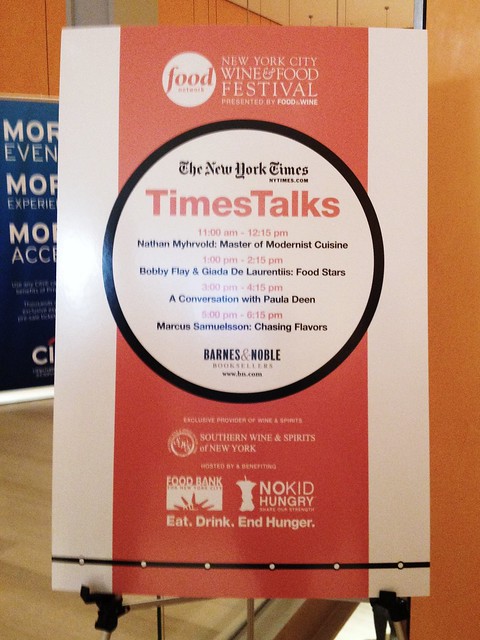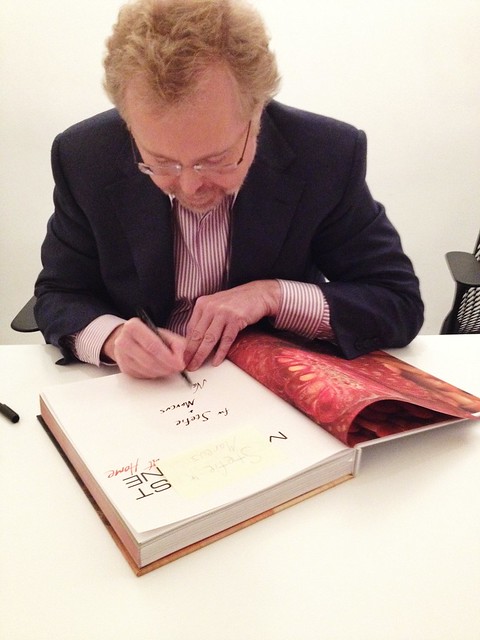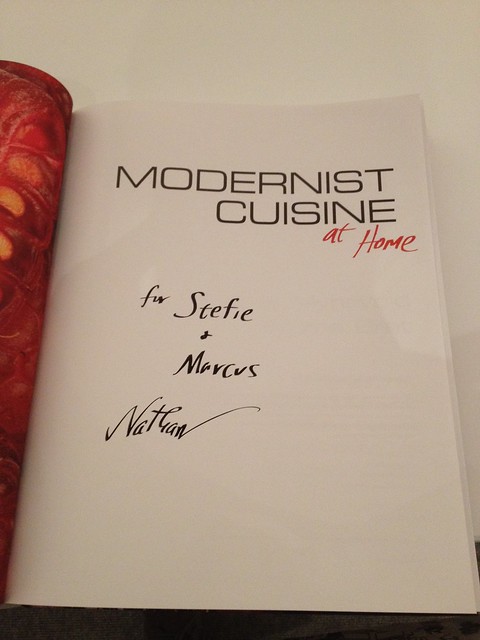So this past week, my pre-ordered copy of Modernist Cuisine at Home arrived via Amazon.com (thank you, Amazon Prime!).

{1} It arrived in its own snug box (fancy, I know!) {2} which even had a "seal" on the it which read "certified frustration-free packaging." I guess it's to ensure that during its potentially bumpy trip from the warehouse to any doorstep, that the book will stay intact without any shipment damage -- no arguments here! {3} When I opened the package quite easily, I found the cookbook to be inside another box -- {4} the book, along with a complimentary waterproof (!) kitchen manual has its own slipcase (what I now dub to be the Russian dolls of the cookbook world). Oh, and did I mention it weights a little over 10 pounds? Yup, I was still planning on lugging this all the way to the lecture.
The original five-volume, 2,400-page of cookbooks, Modernist Cuisine: The Art and Science of Cooking, was created by Mr. Myhrvold with Chris Yong and Maxime Bilet (scientists, inventors, and accomplished cooks) and "reveals science-inspired techniques for preparing food that ranges from the other-worldly to the sublime." The authors, along with their 20-person team at "The Cooking Lab," have "achieved astounding new flavors and textures by using tools such as water baths, homogenizers, centrifuges, and ingredients, such as hydrocolloids, emulsifiers, and enzymes." Their mission for this work is "destined to reinvent cooking." Located in Bellevue, Washington, The Cooking Lab is "a culinary research laboratory and publishing company originally created for Modernist Cuisine" and "houses one of the most sophisticated research kitchens in the world."

The TimesTalk with Mr. Myhrvold was held this past Saturday at 11 AM.

His was part of a series of NYCWFF talks with other renowned food personalities/chefs including Bobby Flay, Giada De Laurentiis, Paula Deen, and Marcus Samuelsson.
Just as a little background (thanks to the pamphlet given at the TimesTalk), before Modernist Cuisine, Mr. Myhrvold had quite a non-culinary dossier of experience. He had graduated with degrees in mathematics, geophysics, and space physics from UCLA as well as with Ph.D.s in mathematical economics and theoretical physics from Princeton. His postdoctoral work at Cambridge University also included working on quantum theories of gravity with Stephen Hawking. Soon after, he became the first chief technology officer at Microsoft, where he established Microsoft Research and oversaw many advanced technology projects. Leaving Microsoft in 1999, he went on to pursue a lifelong interest in cooking and food science. He staged at Seattle's top restaurant, Rover's, for two years before completing culinary training at Ecole de la Varenne. He is now the CEO and founder of Intellectual Ventures, a firm dedicated to creating and investing in inventions. In fact, Mr. Myhrvold himself is an active inventor with nearly 250 patents issued or pending, including several related to food technology.

The event had sold out earlier in the week, so the theatre was completely packed.

Here were some highlights to the stimulating conversation Mr. Gordinier had with Mr. Myhrvold:
- When asked about his original fixation on food, Mr. Myhrvold briefly mentioned for the first Thanksgiving holidays where he sought to cook a meal for his family, he learned that Georges Auguste Escoffier was not the best go-to resource for beginners (i.e., more for advanced cooks) and that the Pyromaniac's Cookbook more suited his skillset and proclivities for flames.
- Mr. Gordonier asked Mr. Myhrvold if his epicurean interests set him apart while he was working in the "techie world" -- Mr. Myhrvold responded that the food groups of a programmer includes caffeine and pizza, so it was a completely different kind of atmosphere.
- Bill Gates isn't too much of a "foodie" as he was puzzled by Mr. Myhrvold's request to take a leave of absence to attend culinary school. He even said to Mr. Myhrvold that Modernist Cuisine is the only one he has ever opened.
- When Mr. Myhrvold built The Cooking Lab, he and his team were looking for cookbooks that divulged the newest and latest cooking techniques. Their search concluded that the market was oversaturated with "classic" approaches to cooking, so in that regard, the world was covered, but when it came to combining science and cooking, there wasn't much out there (though the online culinary/cooking forum, eGullet, which discussed many of these topics). Because this scarcity made it hard for people to learn what these "new" technique may be, this would become the driving force behind creating and publishing Modernist Cuisine.
- Mr. Myhrvold noted that Harold McGee wrote the first books on science's impact on cooking.
- There is a divide between food scientists and chefs -- e.g., sous vide (low heat over long period of time) vs. sautéeing (high heat over short period of time). Because sous vide involved cooking in a new parameter, Mr. Myhrvold couldn't help but think of it in programing terms. He wrote lines of code documenting how heat travels into and through food, in particular, how a piece of steak is cooked. As the interior of a steak is cooked through conduction, the thickness in the cut of steak impacts how long it takes (2 inches versus 1 inch can take up to four times as long to cook). All of this lead to the section of the cookbook which addresses how to cook the perfect steak. People prefer to interior of a steak to taste a certain way (i.e., tender, soft, juicy) and the exterior to taste a certain way (i.e., smoky, charred, and browned). For these reasons, sous vide-ing a steak followed by blowtorching the edges/exterior will accomplish these two desired textures/tastes/flavors.
- When Mr. Gordinier asked about whether or not Mr. Myhrvold had any concerns about the expenditure behind creating a cookbook volume set like Modernist Cuisine, Mr. Myhrvold answered that he was perfectly fine with starting this whole venture with a larger fortune to create a small fortune in the cookbook business. He wanted to take the philosophy from the realm of winemakers -- i.e., make something you love and hope someone else will love it, too -- or even more generally, the artist approach.
- Cooking can be an art (created by an artist) or a craft (created by an artisan), and food spans both these areas, pervading these thoughts in a profound way.
- How cooking works is explained in Modernist Cuisine and Modernist Cuisine at Home -- recipes basically say do this, this, and this, which is very limiting; however, by understanding the scientific principles behind cooking, one can tailor these principles to many recipes and to one's own taste (i.e., ultimately what Modernist Cuisine is trying to accomplish).
- Mr. Myhrvold jokingly said the cover of Modernist Cuisine at Home (i.e., visually deconstructed hamburger) is the National Space Station sandwich -- no gravity!
- Mr. Myhrvold likes to dress his salads by hand, resulting in a better distribution throughout, but he likes to salt his dishes at the end, so that there is a high concentration initially to satisfy the palate yet less salt overall in consumption.
- A blowtorch is a great investment for the kitchen, especially for searing the edge of a steak for charred flavor.
- Barbecuing can be the American way of grilling with charcoal (high heat) or it could be the more traditional way of smoking with woodchips soaked in water (low heat) with the odd but appropriate addition of ice cubes for getting the ideal temperature.
- Mr. Gordinier brought up the example of how roasting a chicken can be a meaningful, culinary ritual observed by many Americans strongly contrasts to the sterile, quite literally lab-like approach (e.g., in a plastic bag) of cooking behind Modernist Cuisine. Mr. Myhrvold's deadpan response: If your kitchen smells delicious, the food cooking at hand is losing something (i.e., flavors). Mr. Gordinier countered, "I feel like the Grinch just stole Christmas again!" Mr. Myhrvold brought up another example where this occurs: Mrs. Field's cookies inside shopping malls. That smell of freshly baked cookies that wafts throughout isn't actually the smell of fresh baking cookies -- it's really vanilla extract cooking over a hotplate on low heat.
- When asked about how traditionalists have reacted to his book, Mr. Myhrvold simply said that most of them haven't actually seen the book, so most change their view once they do.
- Mr. Myhrvold sees Modernist Cuisine as the provider of the best, ultimate recipe/method/technique in how to prepare a said dish/ingredient, as they take a scientific approach to finding the optimal recipes/formulas/principles. His example was how he believes that Modernist Cuisine makes the best ice cream, which strangely enough doesn't even contain cream/milk and is totally vegan. This recipe involves pistachio oil, homogenizing it then adding sugar, stabilizer (protein), and ground pistachios. Another technique involves hyper-decanting wine, which ultimately involves throwing a whole bottle of wine (preferably a younger red wine) into a blender and "frappé" for about 30 seconds.
- When comparing something like gelatin (a very well-known, familiar Western ingredient which is actually created by boiling pig skins) to agar-agar (something lesser known in the mainstream Western family kitchen unless it is a vegan one, yet has been used in Asian for several centuries derived from a seaweed extract) for thickening, it's peculiar to see how certain ingredients have been commonly accepted and others that seem out of place, strange, and foreign to be looked at with raised eyebrows.
- Mr. Myhrvold noted that he gets a lot of people asking him about if and how he cooks with "a chock full of chemicals" in The Cooking Lab and fittingly responds by saying, "Yes we do, and with a chock full of elements, too!" At the end of the day, Modernist Cuisine is all about informed cooking -- science is always in the kitchen; Mr. Myhrvold is just taking the ignorance out of it for the uninformed.

Mr. Myhrvold signing copies of his cookbooks.

Mr. Myhrvold signing my copy of Modernist Cuisine at Home for Marcus and me!

Here's our signed copy! :)
Findings: Hands down, this was probably one of the most interesting lectures (and most educational!) I've attended. I didn't really know much about Modernist Cuisine other than what I've briefly read in articles and such (mainly because I haven't had a chance to get my hands on the original cookbook or the new until this past week). It was so enlightening to hear Nathan Myhrvold speak so eloquently and knowledgeably without skipping at beat about the questions that Jeff Gordinier threw at him during the course of the event. I learned so much in so little time, and I know that I'll continue to learn so much more as I work my way through his tome of a cookbook -- the photographs are already mindblowing, too! I think for Marcus, it was an even more awesome event in that he found it so cool that Mr. Myhrvold approaches things like cooking in the same way he himself does -- very analytical, pragmatic, and rationalist. Plus, he's so laid back and easy to talk to that you wouldn't feel like you're in the presence of estoteric company. His humor and commentary make it that much more enjoyable. Even with the brief audience Q&A session, the questions being thrown at him were mostly complex, and he answered them quite thoroughly and precisely with no hesitation at all. This guy really does know his stuff, so I wouldn't want to mess with him. I'm so grateful to have had the opportunity to attend this lecture. With that being said I would highly recommend attending any events/signings/lectures that feature Mr. Myhrvold because I guarantee you'll be in for a treat.
Price point: $35 per ticket.
--October 13, 2012
The Times Center
TimesTalks
242 West 41st Street
New York, NY 10036
http://thetimescenter.com/calendar.php
http://nytimes.whsites.net/timestalks
New York City Wine and Food Festival
http://nycwineandfoodfestival.com
Modernist Cuisine at Home
Nathan Myhrvold and Maxine Bilet
available here on Amazon.com

No comments:
Post a Comment